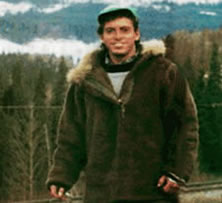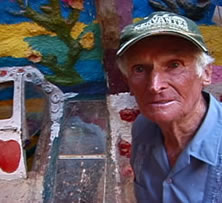The Call of the Wild
Chris McCandless - Spring 1992
CHRIS McCANDLESS, the self-described "aesthetic voyager whose home is the road," died on Alaska’s Stampede Trail in August of 1992. His death followed a two-year cross-country odyssey, a "spiritual pilgrimage" that took him from Atlanta to Arizona, down into Mexico, and from California’s Salton Sea to the streets of Las Vegas and the small town of Carthage, South Dakota, and countless places in between. In the spring of that year, the 24-year-old McCandless had made his way north to Alaska, where he lived in the woods north of Mt. McKinley for 113 days before his death by starvation. In May of 2006, fulfilling a quest fourteen years in the making (see BACKSTORY), I loaded up a backpack and walked out my door here in Concord, Massachusetts, determined to follow in Chris’s footsteps all the way to Fairbanks 142, the abandoned bus where he lived, and died, that summer on Stampede Trail. THE CALL OF THE WILD is a documentary film about this journey (now available for DOWNLOAD).
Over the course of my travels, through some thirty U.S. states, two Canadian provinces, and Mexico, I met and interviewed dozens of people about the McCandless story—some who knew Chris (childhood neighbors; his cross-country coach; his freshman-year roommate at Emory; South Dakotans he befriended), as well as some who didn’t but are linked to the story (most notably, Alaskan dog musher Will Forsberg, who owned a cabin on Stampede Trail less than five miles from the bus, and who later found Chris’s wallet—see Into the Wild DEBUNKED). Whether they knew him or not, whether they eulogize or disparage him, they all make their way into the film, and become part of the larger Chris McCandless mosaic I am trying to piece together.
Dr. Clausen analyzed the potato seeds
for Jon Krakauer
Ironically, and quite unwittingly (though I do keep the camera rolling), I also keep running into Sean Penn and his crew, who are making a Hollywood version of the McCandless story at the same time I’m shooting this documentary (see BACKSTORY for more on this subject). In Alaska, retracing Chris’s final journey all the way to the bus—and nearly succumbing to the Teklanika River on my way there—the film uncovers never-before-seen evidence that sheds new light on the case, and the mystery surrounding Chris’s death. This new evidence directly contradicts both author Jon Krakauer’s interpretation and that of Sean Penn’s new docudrama (again, see Into the Wild DEBUNKED). The film ends with a surprising discovery I made upon my return from Alaska, something that may forever change the way we think about why Chris McCandless didn’t walk out, and the possible meaning of his final S.O.S. note.
Be that as it may, the documentary is about a lot of things besides the controversy over Chris’s death, and the film explores a variety of subjects and themes emanating from the McCandless story: Generation-X; wilderness and the American imagination; youthful rites of passage; the changing American cultural landscape, from fringe USA to hitchhiking in the 21st century; and finally, the independent documentary versus the Hollywood machine. In addition, we see the most extensive location footage to date of the actual sites where Chris lived, worked, and traveled: El Segundo, California; Annandale, Virginia; the Salton Sea; Lake Mead; Mexico; Carthage, South Dakota; the ALCAN highway; and the abandoned bus on Stampede Trail, including footage of the Teklanika at full summer flood.
Long-time Slabber Leonard Knight
More than anything, however, the documentary is a road film, and a piece of reflexive direct cinema in the tradition of Ross McElwee. And despite some of the unpleasant truths that are uncovered in the film, and some of the controversies engaged, or negative opinions given voice for the first time, this film is in the end a celebration of the spirit of Chris McCandless, and a reflection on his legacy. In the final analysis, I’ve come to realize that what he symbolizes for me, and for others, I suspect, transcends questions of his physical health, or his wilderness acumen, or whether there are more remote places to get lost than Stampede Trail. Just as I care little how far Thoreau lived from the train tracks, or whether he mooched off Emerson on occasion, so too with McCandless. Like Thoreau’s experiment at Walden, the greater meaning of Chris’s journey is what lives on. Indeed, there is a deeper truth to be found in the simplicity of his final journal entry—beautiful blueberries—than can be found in any details of his autopsy report. Why he didn’t walk out, perhaps, is less important in the big scheme of things, than why he walked in. The former is fleeting, and peripheral, whereas the latter is timeless, and profound. It is the idealized McCandless, the seeker, who in the end matters most to me.
Ron Lamothe
Concord, Massachusetts
September 2007
|




